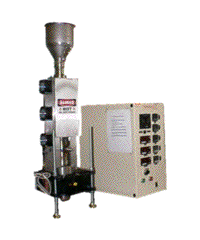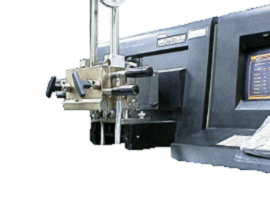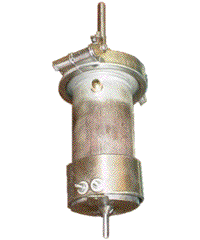|

__________________________________________________Microtruder
 |
The Microtruder is a laboratory scale (tabletop size) single screw extruder. The size is micro but the application is almost same as a commercialized large-scale extruder. This particular vertical screw design gives us micro space occupation and natural gravitational feeding of the polymers. The special die design provides the manufacturing possibility for shaped samples (e.g. Tensile Dog Bone). The micro design is suitable for expensive materials that are developed in small amounts from laboratory scale preparation. |
Mixer / Extruder______________________________________________
The Haake Rheocord 90 is a versatile computer controlled instrument that is capable of mixing, extruding and reading capillary rheometry data. It consists of two main components, the Computer Processing Unit (CPU) and the Measuring Drive Unit (MDU). The CPU controls and records all the information during the run of the experiment. The MDU measures the torque, temperatures, pressures and speeds that are then recorded by the CPU. This mixer, a Rheomix600/610, has the capability to mix at temperatures up to 450ÁC. It contains three heated zones controlled by the MDU. The advantages of using the mixer are a small sample size, more complete mixing, ease of assembly/disassembly, and ease of cleaning. Several different rotor types are available including Banbury, cam, roller, and sigma.
|
 |
|
The HAAKE PolyDrive is a torque rheometer equipped with a single screw extruder for process optimization or product development. It is a robust plug & play instrument featuring automatic sensor recognition with calibration and control of testing procedures via software or the simple, ergonomic keypad and display. A range of accessories is available for extruding polymers, ceramics, food or drugs.
|
The Haake Minilab allows compounding and rheological characterization of expensive materials such as nano-composites, bio-polymers or pharmaceuticals is no problem . Continuous extrusion with a force feeder is possible with little sample quantities.
The MiniLab micro rheology compounder combines real compounding and real rheological measurements with smallest amounts of materials. This is of interest in R&D applications for new polymer development, testing of expensive additives, i.e. pharmaceutical drugs and material studies. The MiniLab compounder can be equipped with conical co and counter rotating screws. Continuous viscosity measurements in the back flow channel up to 350° C.
|
|
_____________________________________________________Atomizer
 |
The Gas Atomization of Polymers (GAP) can be used to produce powders from materials that could not presently be made into powders using other available methods. The Gas Atomization unit is a hand built unit by the group and is divided into three zones. The heating zone is the area where the polymeric material is melted. It is comprised of a large metal crucible and heating components. The atomization zone is the area where the material is atomized into a powder. This area is at the bottom of the crucible, where a specially designed stainless steel pour tube has the polymeric material forced through it at extremely high pressures. The collection zone is by far the largest zone and is simply used to collect the powder after atomization. |
|








